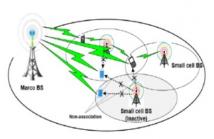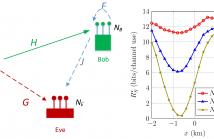
- Read more about A Low-Rank Approach for Interference Management in Dense Wireless Networks
- Log in to post comments
- Categories:
 18 Views
18 Views
- Read more about A probabilistic interference distribution model encompassing cellular LOS and NLOS mmWave propagation
- Log in to post comments
We propose a novel probabilistic model for the interference power distributions in a cellular network employing MIMO beamforming in mmWave spectrum. Considering both line-of-sight (LOS) and non-line-of-sight (NLOS) propagations, we use the Gamma distribution for LOS interference power, and propose a mixture of the Inverse Gaussian and Inverse Weibull distributions for the NLOS interference power. For the NLOS mixture model, an expectation maximization algorithm is developed using both analytical moment matching and maximum likelihood estimation.
- Categories:
 27 Views
27 Views
- Read more about A ROBUST APPLICATION DETECTOR FOR INTELLIGENT WIRELESS COLLABORATION
- Log in to post comments
We present an approach for detecting application level protocols over a wireless communications link, without the need for demodulation or decryption. Our detector is suitable for diverse radio types, since only simple external signal features are used as inputs. We show that the Profile Hidden Markov Model (PHMM) is well suited to this task, due to the probabilistic nature of the wireless channel and the discrete nature of application level traffic. We include results evaluating the detection performance for two application protocols in 802.11 in the presence of background traffic.
- Categories:
 8 Views
8 Views
- Read more about Energy Efficiency Maximization for Heterogeneous Networks: A Joint Linear Precoder Design and Small-cell Switching-off Approach
- Log in to post comments
In heterogeneous networks (HetNets) system, the exploitation of small cells (SCs) will be enhanced spectral efficiency that means guarantee QoS and coverage area to user terminals. We propose a joint linear precoder designproblem to maximize the energy efficiency of the HetNet model. To tackle the cross-tier interference in the HetNets, we exploit zero-forcing precoding where the interference at the users is cancelled out by block diagonalization scheme.
- Categories:
 16 Views
16 Views
- Read more about A MINORIZATION-MAXIMIZATION (MM) ALGORITHM FOR ARTIFICIAL NOISE (AN)-BASED MIMOME SECRECY RATE MAXIMIZATION
- Log in to post comments
We consider the problem of secrecy rate maximization in a multi-input multi-output multi-eavesdropper (MIMOME) wiretap channel and present an exact solution. A general system model with a multi-antenna eavesdropper and a multi-antenna full-duplex receiver is considered. In particular, we perform joint beamforming and artificial noise optimization in an effort to maximize the achievable secrecy rate. The optimization is performed in the presence of artificial noise generated by both transmitter and legitimate receiver. The resulting optimization problem is non-convex and difficult to solve.
- Categories:
 44 Views
44 Views
- Read more about Blind channel gain cartography
- Log in to post comments
Channel gain cartography relies on sensor measurements to construct maps providing the attenuation between arbitrary transmitter-receiver locations. A number of applications involving interference control, such as wireless network planning or cognitive radio, can benet from channel gain maps. Existing approaches capitalize on tomographic models, where shadowing is the weighted integral of a spatial loss eld (SLF) that depends on the propagation environment.
- Categories:
 18 Views
18 Views
- Read more about CACHING POLICY OPTIMIZATION FOR RATE ADAPTIVE VIDEO STREAMING
- Log in to post comments
FD_Poster.pdf
- Categories:
 6 Views
6 Views
- Read more about Energy Efficient Multi-Hop Wireless Backhaul in Heterogeneous Cellular Networks
- Log in to post comments
slides.pdf
- Categories:
 4 Views
4 Views
- Read more about Learning Structural Properties of Wireless Ad-Hoc Networks Non-Parametrically from Spectral Activity Samples
- Log in to post comments
- Categories:
 4 Views
4 Views
- Read more about A New Perspective on Randomized Gossip Algorithms
- Log in to post comments
In this short note we propose a new approach for the design and analysis of randomized gossip algorithms which can be used to solve the average consensus problem. We show how the Randomized Block Kaczmarz (RBK) method—a method for solving linear systems—works as gossip algorithm when applied to a special system encoding the underlying network. The famous pairwise gossip algorithm arises as a special case.
- Categories:
 14 Views
14 Views